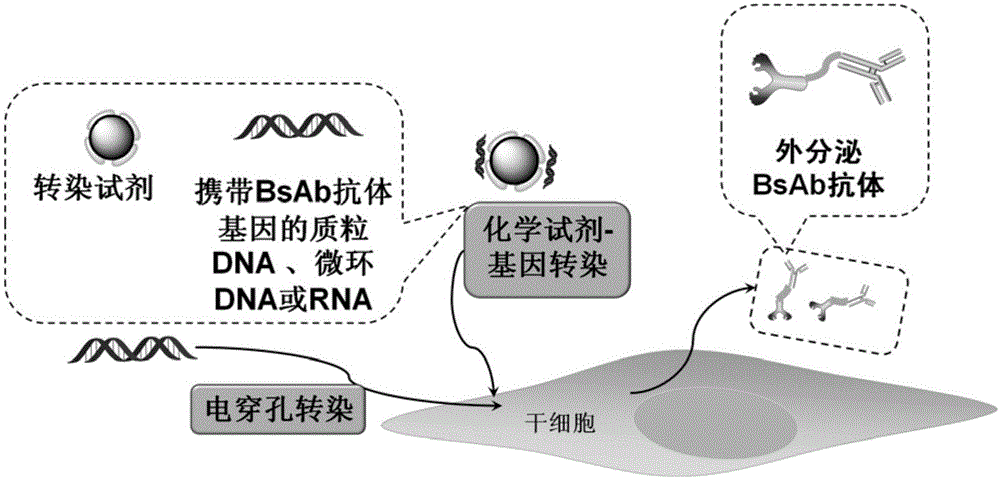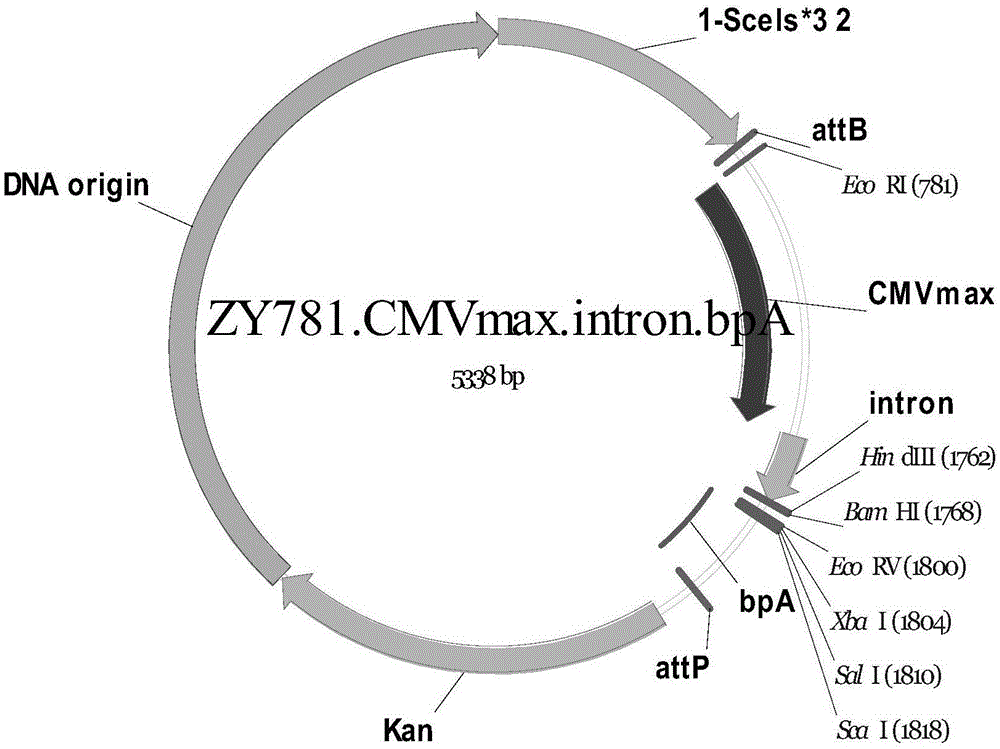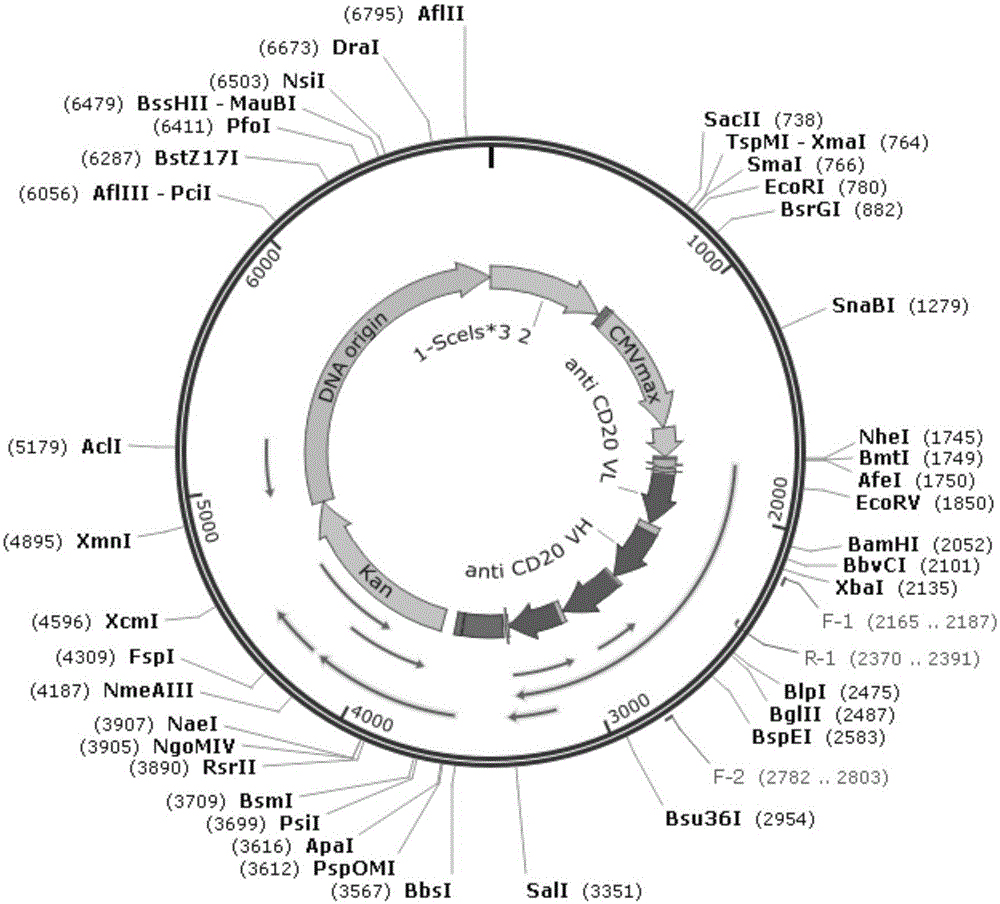Gene-modified mesenchymal stem cell and method for producing BsAb antibody therefrom
A kind of stem cell and gene modification technology, applied in the field of BsAb antibody production, can solve the problems of low transfection efficiency, destruction of cell genome, low molecular weight of protein and functional factors, etc., to reduce purification links, reduce contact probability, and increase the difficulty of preservation Effect
- Summary
- Abstract
- Description
- Claims
- Application Information
AI Technical Summary
Problems solved by technology
Method used
Image
Examples
Embodiment 1
[0038] Example 1. Carrying out chemical reagent transfection for mesenchymal stem cells derived from human umbilical cord
[0039] (1) Preparation of Lipofectamine2000 / DNA transfection complex
[0040] a. Preparation of plasmid DNA containing antiCD20×antiCD3 antibody expression gene
[0041] In this example, the antiCD20×antiCD3 gene sequence (SEQ ID No.1, which is transformed into a bispecific single-chain antibody sequence based on the humanized monoclonal antibody anti-CD20 sequence) The antiCD20 sequence is derived from: GA101 (Obinutuzumab, Roche), and the antiCD3 part is derived from the patent US008076459) cloned into the vector SZ63.pMC.ZY781.CMVmax.intron.bpA. Provided by Therapeutic Research Laboratory, its detailed spectrum is as follows figure 2 As shown, the sequence is shown in SEQ ID No.2 (artificial sequence), wherein the drug screening marker is Kanamycin), and the recombinant plasmid SZ66.pMC.ZY781.CMVmax.intron.CD20Bite.bpA (6880bp) is obtained after tra...
Embodiment 2
[0062] Example 2. Electrotransfection of human umbilical cord-derived mesenchymal stem cells
[0063] 18μl Supplement solution [P3Primary Cell 4D-Nucleofector TM X Kit, Lonza Company] with 82 μl NucleofectorTM solution [P3Primary Cell 4D-Nucleofector TM X Kit, Lonza Company] was fully mixed to form an electrotransfer solution (100 μl system / electrotransfer cup); the mesenchymal stem cells (provided by Shenzhen Nanshan Hospital) were digested with trypsin to make them fall off the culture dish wall, and centrifuged (1000rpm, 5 min), the supernatant was discarded, and the mesenchymal stem cells were resuspended with 100 μl electroporation solution to make the density reach 1×10 7 pc / ml; Add 6 μg of plasmid DNA plasmid with antiCD20×antiCD3-BsAb antibody expression gene to 100 μl of mesenchymal stem cell resuspension (see Example 1 for plasmid preparation), and mix gently with a pipette to make the cells Mix the plasmid well; add the mixture into the electric transfer cup, us...
Embodiment 3
[0064] Example 3. Nanocomposite-mediated transfection of human umbilical cord-derived mesenchymal stem cells
[0065] Add 4 μg of the plasmid DNA plasmid with antiCD20×antiCD3 antibody expression gene (see Example 1 for plasmid preparation) to an appropriate amount of opti-MEM medium, with a final volume of 100 μl, and let it stand for 5 minutes; at the same time, take an appropriate amount of ε-caprolactone The modified modified polyethyleneimine (patent application No. 201310390436.1) was dissolved in opti-MEM medium, and the final volume was 100 μl to prepare a transfection agent solution. After standing for 5 minutes, the plasmid solution and transfection reagent were mixed with a pipette. The solution was gently blown up and down to mix, and left at room temperature for 30 minutes to make a plasmid DNA nanocomposite.
[0066] Human umbilical cord-derived mesenchymal stem cells were used at 5×10 per well 5 The density of cells / ml was inoculated in 6-well plates (5×10 per ...
PUM
 Login to View More
Login to View More Abstract
Description
Claims
Application Information
 Login to View More
Login to View More - Generate Ideas
- Intellectual Property
- Life Sciences
- Materials
- Tech Scout
- Unparalleled Data Quality
- Higher Quality Content
- 60% Fewer Hallucinations
Browse by: Latest US Patents, China's latest patents, Technical Efficacy Thesaurus, Application Domain, Technology Topic, Popular Technical Reports.
© 2025 PatSnap. All rights reserved.Legal|Privacy policy|Modern Slavery Act Transparency Statement|Sitemap|About US| Contact US: help@patsnap.com



